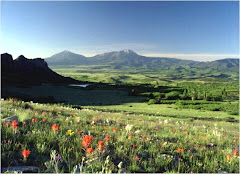For those of you that use or are interested in the Mizuno Wave Universe 3, you may find this interesting. Long story short, the reported 9mm heel differential is really only 3mm. For the full story, link here: http://edwardedmonds.com/.
Update October 8, 2010: A few weeks ago I started wearing size 9’s in the MWU3’s, up a half size. I think this is great evidence to support the idea that if you have a generous toe box your foot will widen when unconfined. More importantly though, a new discovery. A new discovery I had been suspicious about for a long time. The Running Warehouse website gives a heel-to-toe ratio of 15mm in the heel and 6mm in the forefoot. For a long time I've been suspicious about this measurement because it seemed wrong. But at almost $100 bucks a pop and plenty of miles still left in even my old est ones I didn't want to slice them up to see. Now that I've sized up, taking my beloved flats to the chop shop was justified. I sliced them in half from front to back and measured the real heel-to-toe ratio. Surprise, surprise: <= 3-4mm of difference. That’s a big difference from the original. I thought for a moment… “well maybe I've worn them for so long that I've flattened them out”… nope, if that was the case the difference between the heel and toe would have increased with the forefoot portion becoming more compressed and the heel staying the same as my heels never touch the ground… so not possible.
The reason why the measurements are different is because the outside of the mid-sole is built up around the edges to support the upper in other words the mid-sole is concave. If you measure the outside then yes you get a big difference. But when you cut them in half and measure where your foot actually sits–bingo–big difference. So once again another testament to what I think is the best flat out there. My wife is in Spain right now with the cam era so no pictures yet, but I did buy a brand new translucent ruler just to give ya’ll some tangible proof.

 Mizuno Wave Universe 3 dissection" width="640" height="480" style="background-image: initial; background-attachment: initial; background-origin: initial; background-clip: initial; background-color: transparent; border-top-width: 0px; border-right-width: 0px; border-bottom-width: 0px; border-left-width: 0px; border-style: initial; border-color: initial; margin-top: 5px; margin-right: 5px; margin-bottom: 0px; margin-left: 5px; padding-top: 0px; padding-right: 0px; padding-bottom: 0px; padding-left: 0px; vertical-align: baseline; border-top-style: none; border-right-style: none; border-bottom-style: none; border-left-style: none; border-width: initial; border-color: initial; height: auto; max-width: 640px; width: auto; background-position: initial initial; background-repeat: initial initial; ">
Mizuno Wave Universe 3 dissection" width="640" height="480" style="background-image: initial; background-attachment: initial; background-origin: initial; background-clip: initial; background-color: transparent; border-top-width: 0px; border-right-width: 0px; border-bottom-width: 0px; border-left-width: 0px; border-style: initial; border-color: initial; margin-top: 5px; margin-right: 5px; margin-bottom: 0px; margin-left: 5px; padding-top: 0px; padding-right: 0px; padding-bottom: 0px; padding-left: 0px; vertical-align: baseline; border-top-style: none; border-right-style: none; border-bottom-style: none; border-left-style: none; border-width: initial; border-color: initial; height: auto; max-width: 640px; width: auto; background-position: initial initial; background-repeat: initial initial; "> Mizuno Wave Universe 3 heel height is 10mm" width="640" height="480" style="background-image: initial; background-attachment: initial; background-origin: initial; background-clip: initial; background-color: transparent; border-top-width: 0px; border-right-width: 0px; border-bottom-width: 0px; border-left-width: 0px; border-style: initial; border-color: initial; margin-top: 5px; margin-right: 5px; margin-bottom: 0px; margin-left: 5px; padding-top: 0px; padding-right: 0px; padding-bottom: 0px; padding-left: 0px; vertical-align: baseline; border-top-style: none; border-right-style: none; border-bottom-style: none; border-left-style: none; border-width: initial; border-color: initial; height: auto; max-width: 640px; width: auto; background-position: initial initial; background-repeat: initial initial; ">
Mizuno Wave Universe 3 heel height is 10mm" width="640" height="480" style="background-image: initial; background-attachment: initial; background-origin: initial; background-clip: initial; background-color: transparent; border-top-width: 0px; border-right-width: 0px; border-bottom-width: 0px; border-left-width: 0px; border-style: initial; border-color: initial; margin-top: 5px; margin-right: 5px; margin-bottom: 0px; margin-left: 5px; padding-top: 0px; padding-right: 0px; padding-bottom: 0px; padding-left: 0px; vertical-align: baseline; border-top-style: none; border-right-style: none; border-bottom-style: none; border-left-style: none; border-width: initial; border-color: initial; height: auto; max-width: 640px; width: auto; background-position: initial initial; background-repeat: initial initial; "> Mizuno Wave Universe 3 forefoot height 7mm" width="640" height="480" style="background-image: initial; background-attachment: initial; background-origin: initial; background-clip: initial; background-color: transparent; border-top-width: 0px; border-right-width: 0px; border-bottom-width: 0px; border-left-width: 0px; border-style: initial; border-color: initial; margin-top: 5px; margin-right: 5px; margin-bottom: 0px; margin-left: 5px; padding-top: 0px; padding-right: 0px; padding-bottom: 0px; padding-left: 0px; vertical-align: baseline; border-top-style: none; border-right-style: none; border-bottom-style: none; border-left-style: none; border-width: initial; border-color: initial; height: auto; max-width: 640px; width: auto; background-position: initial initial; background-repeat: initial initial; ">
Mizuno Wave Universe 3 forefoot height 7mm" width="640" height="480" style="background-image: initial; background-attachment: initial; background-origin: initial; background-clip: initial; background-color: transparent; border-top-width: 0px; border-right-width: 0px; border-bottom-width: 0px; border-left-width: 0px; border-style: initial; border-color: initial; margin-top: 5px; margin-right: 5px; margin-bottom: 0px; margin-left: 5px; padding-top: 0px; padding-right: 0px; padding-bottom: 0px; padding-left: 0px; vertical-align: baseline; border-top-style: none; border-right-style: none; border-bottom-style: none; border-left-style: none; border-width: initial; border-color: initial; height: auto; max-width: 640px; width: auto; background-position: initial initial; background-repeat: initial initial; "> Mizuno Wave Universe 3 forefoot height 7mm" width="640" height="480" style="background-image: initial; background-attachment: initial; background-origin: initial; background-clip: initial; background-color: transparent; border-top-width: 0px; border-right-width: 0px; border-bottom-width: 0px; border-left-width: 0px; border-style: initial; border-color: initial; margin-top: 5px; margin-right: 5px; margin-bottom: 0px; margin-left: 5px; padding-top: 0px; padding-right: 0px; padding-bottom: 0px; padding-left: 0px; vertical-align: baseline; border-top-style: none; border-right-style: none; border-bottom-style: none; border-left-style: none; border-width: initial; border-color: initial; height: auto; max-width: 640px; width: auto; background-position: initial initial; background-repeat: initial initial; ">
Mizuno Wave Universe 3 forefoot height 7mm" width="640" height="480" style="background-image: initial; background-attachment: initial; background-origin: initial; background-clip: initial; background-color: transparent; border-top-width: 0px; border-right-width: 0px; border-bottom-width: 0px; border-left-width: 0px; border-style: initial; border-color: initial; margin-top: 5px; margin-right: 5px; margin-bottom: 0px; margin-left: 5px; padding-top: 0px; padding-right: 0px; padding-bottom: 0px; padding-left: 0px; vertical-align: baseline; border-top-style: none; border-right-style: none; border-bottom-style: none; border-left-style: none; border-width: initial; border-color: initial; height: auto; max-width: 640px; width: auto; background-position: initial initial; background-repeat: initial initial; ">